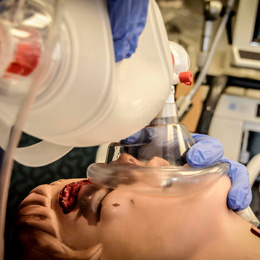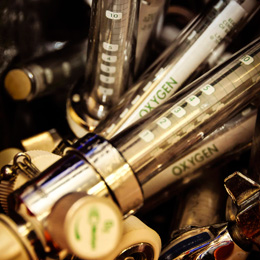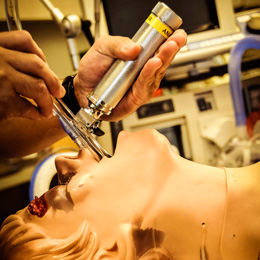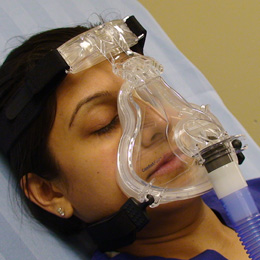 As respiratory therapists, we pride ourselves on our diverse skill set. Our unique expertise in airway management, oxygen therapy, home care, pulmonary rehabilitation, mechanical ventilation and end of life care enhances our patient's cardio-respiratory status.
As respiratory therapists, we pride ourselves on our diverse skill set. Our unique expertise in airway management, oxygen therapy, home care, pulmonary rehabilitation, mechanical ventilation and end of life care enhances our patient's cardio-respiratory status.
As a strong, integrated team, we strive to provide the most dignified, advanced and evidence-based care.
Despite our focus on the flutter and fury of crisis management in critical situations, it is when the situation allows that we make the most rewarding contribution and personal connections with our patients and their families.
Respiratory therapy services can be found in most areas of a hospital, including:
- Intensive care units
- General hospital wards
- Emergency departments
- Pulmonary function and sleep labs
- Operating rooms
- Patient simulation training
- Pulmonary rehabilitation
- Hyperbaric chamber
- Complex continuing care
Stories from Respiratory Therapists
What We Do
 Respiratory therapists are health care professionals who specialize in helping people breathe. Ours is a diverse and specialized profession that assists the medical team in diagnosing, treating, and managing patients and their respiratory treatment and assessment. A respiratory therapist also acts as a patient advocate and facilitates communication between the patient, family, physician and other health care professionals.
Respiratory therapists are health care professionals who specialize in helping people breathe. Ours is a diverse and specialized profession that assists the medical team in diagnosing, treating, and managing patients and their respiratory treatment and assessment. A respiratory therapist also acts as a patient advocate and facilitates communication between the patient, family, physician and other health care professionals.
Key Responsibilities
A respiratory therapist:
- responds to emergency situations to provide airway management 24 hours a day
- initiates mechanical ventilation, assesses and monitors respiratory parameters and patient tolerance to mechanical ventilation
- makes changes in parameters and monitors weaning parameters to complement the medical teams care
- performs invasive procedures that are within the scope of respiratory therapy such as tracheostomy changes, bronchoscopy assistance, arterial/venous blood gas sampling and analysis, endotracheal intubations, arterial line insertion and intravenous line insertion
- performs diagnostic test procedures pertaining to respiratory therapy: pulmonary function tests, peak flow measurements, pulse oximetry, and sleep apnea testing
- performs cardio-pulmonary resuscitation
- reviews test results for accuracy and communicate findings to the appropriate health care team member
- provides technical support to anesthetists in the operating room
- completes respiratory physical assessment of referred clients including planning/recommending, implementing, administering, and discontinuing respiratory therapeutic interventions
- administers aerosol pharmaceutical agents to clients in accordance with medical orders, observe side effects, assess efficacy of treatment and document appropriately
- advocates for the dignity and self-respect of patients
- promotes the autonomy of patients and help them to express their health needs and values to obtain appropriate information and services
- assesses the patient for physical needs, their knowledge of their health, respiratory process and learning needs
- develops, revises and evaluates on an ongoing basis, educational resources necessary to support patients
- administers medical gases and aerosol therapy to manage and control breathing difficulties
- provides coaching and leadership to peers, students and other members of the health care team to develop skill levels necessary to achieve the standard of care.
- collaborates with peers and other members of the health care team to advocate health care environments that are conducive to ethical practice and to the health and well-being of patients and others in the setting
- develops and maintains current resource material in the Respiratory Therapy Department to promote current and accurate practice in respiratory care for use by staff and clients.
 Respiratory Therapists are Patient Advocates
Respiratory Therapists are Patient Advocates
I recognized that the family of one of my patient did not fully understand the importance and reasons for the medical therapy (BiPAP) that my patient was receiving.
I took the time to initiate a discussion with the medical team regarding no CPR status and how it fit into the care plan for this patient. I also helped the resident in communicating to the family the effects and expected outcome of the treatment (BiPAP) to prevent potential communication gap.
To me, being a respiratory therapist means being that critical link between my patient and the medical team, representing the family's wishes, and providing treatment appropriate to my patient's medical needs in a safe and caring manner. Hearing the gratitude from a family and getting recognition from the medical team truly is fulfilling and rewarding.
– Respiratory Therapist
Home from the ICU
The Respiratory Therapy Department in partnership with the Intensive Care team and the Community Care Access Centre facilitated the discharge of a ventilated patient directly from the ICU to home. The Respiratory Therapy team worked together to secure appropriate equipment, provide education and encourage the patient's independence.
Respiratory therapists are always working tirelessly to reach a patient's goal of going home. A recent email summarized one patient's joy in the simple things: "And after more than a year without my own sink, it's more than luxury to be able to brush my teeth in a sink and wash my face in hot running water – it's heaven!!"
– Respiratory Therapist, Intensive Care Unit
Careers
UHN is a work place where you will enjoy the unique challenges of your chosen field, create and engage in best practices, and you will be at the heart of facilities bringing the world new health care innovations.
Find out more at
UHN Careers.
